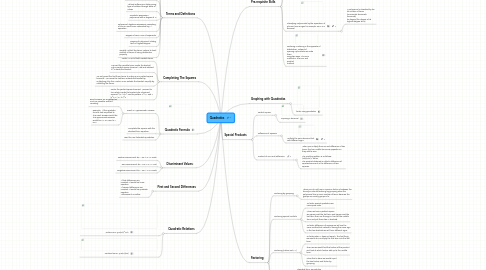
1. Discriminant Values:
1.1. Positive Discriminant: b2 – 4ac > 0 = 2 roots
1.2. Zero Discriminant: b2 – 4ac = 0 = 1 root
1.3. Negative Discriminant: b2 – 4ac < 0 = 0 roots
2. Terms and Definitions
2.1. Quadratic: an equation that represents the curve of best fit for a set of data
2.2. Parabola: curved line in a quadratic function/equation; always shaped/symmetrical
2.3. Vertex: the point where the parabola changes direction; it can be max/min
2.4. 1st/2nd Differences: determining type of relation through table of values
2.5. Quadratic Expression: polynomial with a degree of 2
2.6. Polynomial: algebraic expression consisting of one or more terms connected by +/- operators
2.7. Degree of Term: sum of exponents
2.8. Degree of Polynomial: stating term of highest degree
2.9. Simplify: collect like terms, reduce to least number of terms all using distributive property
3. First and Second Differences
3.1. -If first differences are constant, it would be linear equation -If second differences are constant. it would be quadratic equation -Otherwise it is neither
4. Quadratic Relations
4.1. Vertex Form: y=a(x-h)^2+k
4.2. Factored Form: y=a(x-r)(x-s)
5. Completing The Squares
5.1. Factor 'a' out of both variable terms.
5.2. Convert the variable terms inside the bracket into a perfect square trinomial. Add and subtract b^2 inside the bracket.
5.3. We only need the first three terms to make up our perfect square trinomial. We move the last term outside the bracket by multiplying it by the a value. Once outside the bracket, simplify by collecting like terms.
5.4. Factor the perfect square trinomial. We want to turn what's inside the bracket into a binomial squared [ (x – h)2 ]. Use the pattern: a^2 + 2ab + b^2 = ( a + b )^2
6. Quadratic Formula
6.1. Exact vs. Approximate Answers
6.1.1. Exact answers are simplified as much as possible, without rounding.
6.1.2. Example: If the quadratic formula had simplified to The exact answers would be The approximate answers would be x ≈ 3.73 and x ≈ 0.27
6.2. Complete the squares with the standard form equation.
6.3. Used for non-factorable quadratics.
7. Pre-requisite Skills
7.1. Multiply Polynomials
7.1.1. Consists of distributing two binomials into each other. As the first term in the bracket will multiply into the second bracket and so forth.
7.2. Distributing brackets and simplifying the expression
7.2.1. Distribution & Collecting Like Terms
7.2.1.1. Distributive property is used to expand algerbraic expressions
7.2.1.2. Once you have expanded you must simplify the expression by collecting like terms
7.2.1.3. If you are distributing with a non-constant term (i.e. A term with a variable), then the exponent laws apply
7.3. Classifying Polynomials by the separation of plus and minus signs for example: 2x+3 is a binomial.
7.3.1. A polynomial is classified by its:: Its number of terms (monomials, binomials, trinomials) Its degree (the degree of its highest degree term)
7.4. Factoring: Factoring is the opposite of distribution. Instead of opening up brackets we make them. using two ways. The GCF method or The sum and product method.
8. Graphing with Quadratics
8.1. factor using quadratics
9. Special Products
9.1. Perfect Square:
9.1.1. squaring a binomial
9.2. Difference of Squares:
9.2.1. multiply the same binomial but with different signs
9.3. Product of Sum and Difference
9.3.1. When you multiply the sum and difference of two terms, the two middle terms are opposite, so they add to zero. The resulting pattern is as follows: (a-b)(a+b) = a2-b2 The product obtained is called a difference of squares because it is the difference of two squares.
10. Factoring
10.1. Factoring by grouping
10.1.1. When you do not have a common factor in between the terms you should factoring by grouping when the polynomial has an even number of terms because the groups are usually groups of 2.
10.2. Factoring Special Profucts
10.2.1. To factor special quadratics we use square roots.
10.2.2. When we have a perfect square we square root the first term and square root the last term then use the sign in front of the middle term and put those two in brackets.
10.2.3. To factor difference of squares we will use the same method but instead of having the same sign in the two brackets we will have different signs.
10.3. Factoring (a does not = 1)
10.3.1. To factor when A does not equal 1 the first thing we would do is multiply the first term into the last term.
10.3.2. Then we we would find the factors of the product and look at which factors add up to the middle term.
10.3.3. When that is done we would input the two factors and factor by grouping.
10.4. Factoring (a=1)
10.4.1. Standard form: a2+2ab+b2
10.4.2. Factored form: a(x-r)(x-s)
10.4.3. To factor when a=1 we usually take the factors of the the last term and see which two factors add up to the first term
10.5. Common Factors
10.5.1. Factor by grouping
10.5.2. Use Greatest Common Factor to simplify the polynomial
